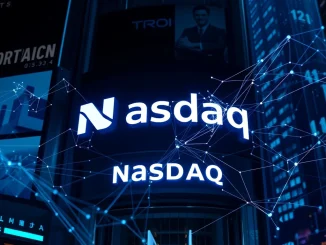
The world of cryptocurrency is no stranger to dramatic shifts and astonishing gains, but few assets command attention quite like Bitcoin. Its journey from an obscure digital experiment to a global financial powerhouse has been nothing short of phenomenal. For those who believed early, the returns have been truly life-changing, with some seeing their initial investments surge by as much as 20,000%. This incredible trajectory continues to unfold, driven by a powerful confluence of factors, most notably the escalating institutional activity that is fundamentally reshaping the crypto market landscape. Let’s delve into the forces propelling Bitcoin’s ascent and what it means for the future of digital finance.
Bitcoin Price: A Journey of Unprecedented Growth
When we talk about Bitcoin’s value, we’re discussing a story of consistent, albeit volatile, appreciation. The Bitcoin price has seen remarkable highs, transforming early adopters into millionaires. Consider the staggering example mentioned: 2,000 Bitcoins purchased for a mere $500 each in 2016. That initial $1 million investment has since ballooned to approximately $200 million, a testament to the power of long-term conviction in this digital asset. This isn’t just a fleeting trend; historical analysis shows a consistent pattern of Bitcoin surges following periods of monetary easing, positioning it increasingly as a ‘digital gold’ equivalent.
What underpins this extraordinary growth? Several key factors contribute to Bitcoin’s rising value:
- Scarcity: With a hard cap of 21 million coins, Bitcoin’s supply is finite, making it inherently deflationary compared to fiat currencies.
- Increasing Adoption: Beyond individual investors, a growing number of businesses and payment processors are integrating Bitcoin, enhancing its utility.
- Network Effects: As more users, developers, and institutions join the Bitcoin network, its value and security are amplified.
- Macroeconomic Factors: In times of economic uncertainty or inflation, investors often seek safe-haven assets, and Bitcoin is increasingly seen as a viable alternative to traditional stores of value.
While price fluctuations are a natural part of any emerging asset class, the overarching trend for Bitcoin has been one of significant appreciation, consistently attracting both retail and institutional interest.
Institutional Bitcoin: The New Cornerstone of the Crypto Market
Perhaps the most significant development bolstering Bitcoin’s prospects is the relentless surge in institutional Bitcoin activity. We’re witnessing a paradigm shift where major financial entities are not just observing but actively participating in the Bitcoin ecosystem. The approval and success of Bitcoin Exchange-Traded Funds (ETFs) have been a game-changer, providing a regulated and accessible avenue for traditional investors to gain exposure to Bitcoin without directly holding the asset. These ETFs are absorbing vast amounts of Bitcoin, often exceeding the supply generated by miners, creating a demand-side pressure that naturally supports higher prices.
This institutional embrace extends beyond ETFs. We’ve seen significant over-the-counter (OTC) trades facilitated by firms like Galaxy Digital, which recently executed a monumental $9 billion Bitcoin trade involving over 80,000 BTC. This transaction, one of the largest in history, demonstrates the increasing maturity and depth of institutional crypto markets. Such large-scale movements, handled discreetly via OTC desks, minimize impact on open market prices, showcasing sophisticated market infrastructure capable of handling massive liquidity. The involvement of such prominent players reinforces Bitcoin’s status as a strategic, long-term asset, further fortifying investor confidence and market stability.
Inside the Crypto Market: Navigating Volatility and Dominance
The crypto market is known for its dynamism and, at times, its volatility. However, the narrative is evolving. While short-term price swings remain a characteristic, the increasing institutional dedication to Bitcoin appears to be providing a new layer of stability and confidence. This shift is crucial, as it suggests a move beyond speculative trading towards a more fundamental valuation based on long-term holding and strategic asset allocation.
Bitcoin’s dominance within the broader crypto market is also amplified by these trends. As institutional capital flows primarily into Bitcoin, its perceived value is amplified, potentially driving up its market share. Changes in Bitcoin’s price dynamics inevitably influence related financial instruments and the altcoin market. When Bitcoin thrives, it often creates an ‘altcoin season’ where other digital assets also see gains. Conversely, a Bitcoin downturn can lead to a broader market correction. Recent trends strongly indicate a significant shift toward Bitcoin as the preferred form of digital wealth, solidifying its position as the undisputed leader in the crypto space.
Bitcoin Mining: The Unsung Heroes and Corporate Giants
Behind the scenes of Bitcoin’s value lies the intricate world of Bitcoin mining, a competitive industry that secures the network and introduces new coins into circulation. While often dominated by large-scale, corporate mining firms, the improbable victories of solo miners serve as a powerful reminder of the decentralized ethos of Bitcoin. The article highlights two remarkable instances: a solo miner successfully mining block 907283 in July 2025, collecting a 3.125 BTC block reward plus transaction fees, and another who used just 2.3 petahashes to solve a puzzle in February 2025, earning a substantial block subsidy.
These solo triumphs are against immense odds. The current Bitcoin network difficulty, floating near all-time highs at approximately 126 trillion, forces miners to expend ever-greater computing power and energy resources to mine a single block. This rising difficulty, coupled with the reduced block subsidy (currently 3.125 BTC per block after the halving), squeezes profit margins for even established corporations. Consequently, many large mining operations are diversifying their business models, venturing into AI data centers and high-performance computing to offset shortfalls in their core mining business and navigate the rising competition. The industry’s reliance on cheap energy resources makes it vulnerable to external factors like weather events and power continuity, as seen in June when Texas miners curbed consumption to avoid peak demand charges.
Decoding Whale Transactions: Impact on Bitcoin’s Value
Large transactions, often referred to as ‘whale movements,’ frequently capture the attention of the crypto community due to their potential impact on Bitcoin’s value. Two recent instances underscore this fascination:
The Patient HODLer’s $200 Million Move
A massive transaction involving 2,000 Bitcoins, originally purchased for just $500 each in 2016, recently stirred excitement. This stash, now worth approximately $200 million, belonged to a long-term holder – a true ‘HODLer’ (a crypto term for holding onto an asset through volatility). The wallet had remained dormant for nearly eight years, leading to speculation about its owner. The fact that someone held through the wild swings of 2017’s bull run, 2018’s crash, and the 2021 frenzy is a profound testament to their conviction in Bitcoin’s long-term potential. While the exact purpose of the move (selling, cold storage, exchange transfer) remains unclear, such a large, old coin movement can inspire confidence, showing early believers reaping massive rewards.
The Satoshi-Era Whale and Galaxy Digital’s Historic Trade
Even more monumental was Galaxy Digital’s execution of a $9 billion Bitcoin trade, selling over 80,000 BTC on behalf of a Satoshi-era whale – one of the earliest known holders of Bitcoin, possibly dating back to 2010. Coins from this era carry a mythical status, rarely moving. This transaction, executed through Galaxy Digital’s OTC desk, ensured minimal impact on open market prices, preventing potential volatility. While the reason for the sale could be profit-taking, estate planning, or asset reallocation, it doesn’t necessarily signal bearish intent. Instead, it highlights the increasing sophistication and liquidity of institutional crypto markets, capable of handling multi-billion-dollar deals without destabilizing the market. It’s a powerful reminder of Bitcoin’s incredible journey from anonymous mining on laptops to massive institutional-grade transactions.
Conclusion: Bitcoin’s Enduring Appeal and Maturing Market
Bitcoin’s journey is far from over. Its incredible surge in value, fueled by robust institutional activity and the unwavering conviction of long-term holders, underscores its evolving role in the global financial landscape. From the strategic accumulation by ETFs to the groundbreaking multi-billion-dollar whale transactions facilitated by institutional players, the market is demonstrating unprecedented maturity. While the competitive world of Bitcoin mining continues to adapt to rising difficulty, and individual successes against the odds highlight its decentralized spirit, the overarching narrative is clear: Bitcoin is solidifying its position as a foundational asset in the digital age. The power of holding, combined with the increasing embrace from established finance, paints a compelling picture of Bitcoin’s enduring appeal and its potential for continued growth. As the crypto market continues to evolve, Bitcoin remains the focal point, driving innovation and reshaping how we perceive and manage wealth.
Frequently Asked Questions (FAQs)
Q1: What is driving Bitcoin’s recent surge in value?
Bitcoin’s recent surge is primarily driven by increasing institutional activity, particularly through Bitcoin ETFs that absorb significant supply, and large-scale private transactions indicating strong long-term holder confidence. Macroeconomic factors, such as the search for inflation hedges, also play a role.
Q2: How do Bitcoin ETFs influence the market?
Bitcoin ETFs provide a regulated and accessible way for traditional investors to gain exposure to Bitcoin. By absorbing large amounts of Bitcoin from the market, often exceeding the supply from miners, ETFs create significant demand pressure, which helps to bolster Bitcoin’s price and market sentiment.
Q3: What are ‘whale transactions’ and why are they important?
Whale transactions refer to the movement of very large amounts of cryptocurrency by individual or institutional holders (known as ‘whales’). They are important because their scale can potentially influence market prices, especially if the coins are moved to exchanges for selling. However, if handled via OTC desks, their market impact can be minimized. They also signal confidence or strategic shifts by major players.
Q4: Is solo Bitcoin mining still possible, given the high network difficulty?
While extremely difficult due to the rising network hashrate and mining difficulty, solo Bitcoin mining is still theoretically possible, as evidenced by recent successes mentioned in the article. However, the odds are heavily stacked against individual miners compared to large, well-resourced corporate operations.
Q5: How are large Bitcoin mining companies adapting to challenges like rising difficulty and reduced rewards?
Large Bitcoin mining companies are adapting by seeking the cheapest energy resources to maintain maximum uptime and diversifying their operations. Many are expanding into high-performance computing and AI data centers to generate additional revenue streams and offset the challenges of rising network difficulty and reduced block rewards.
Q6: What is the significance of Satoshi-era Bitcoin movements?
Satoshi-era Bitcoins are those mined or acquired in the earliest days of the network, potentially by Bitcoin’s anonymous creator or very early adopters. Their movement is significant because these coins have been dormant for over a decade, and their activation often sparks speculation about the identity of the holder and signals a major shift in long-term conviction or asset allocation.



